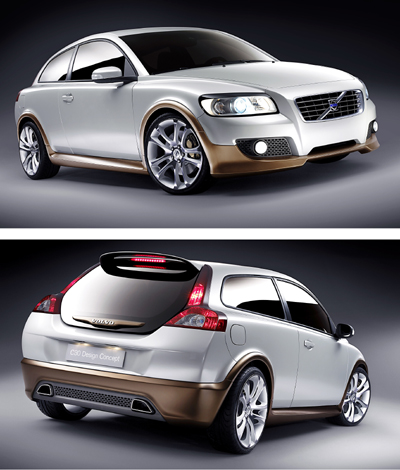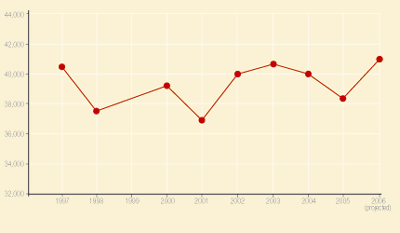In fact, he suggests that had it not been for the performance of the retail network, 2005 would’ve been even worse. “We had no new cars in a market that was down 5%. It’s testament to our dealers that we sold as many as we did,” Reid says.
Retailers have questioned the judgment behind those budgeted figures as the 2005 new car market was tipped by many at the start of the year to be down by between 4-6%. But despite missing the national sales target, the retail network averaged around 2% return on sales, with the best achieving more than 3%.
Just 23 of 151 dealerships were not profitable (15%), although the response by retailers to the RMIF attitude survey suggests a number of areas are causing dissatisfaction, including a drop in average retained margins and Volvo’s marketing stance.
“The Volvo franchise is very profitable in the right hands with strong management,” says Reid. “We are not embarrassed about dealers making lots of money as long as they do a proper job for the brand.”
Retailers should be more confident about Reid’s predicted rise to 41,000 units this year – in a market that’s expected to be down by 2.7% – because Volvo has a number of new products due for launch.
Key are the C30, a coupé that lowers Volvo’s entry point while moving the brand upmarket and into a new sector; the range topping S80, charged with taking the fight to the German premium brands; and the C70 coupé/convertible with its stunning three-section folding metal roof.

Volvo hopes the C30 will attract a new customer base
“41,000 sales on the back of these new models is well within reach of our dealers,” says Reid. “This year is payback time for them in terms of growth and profitability.”
A surge will have to come in the second half of the year (C30 and S80 are due in autumn), with dealers playing catch up – sales in January and February have slipped by more than 33%.
#AM_ART_SPLIT# Reid is pressing retailers to put greater emphasis on used cars. The network sold 27,000 used Volvos and about 6,000 other marques last year, but he wants dealers to aim for a 1:1 target. The Volvo Select used car programme is due for a rejuvenation and will be taken closer to the customer through, for example, internet sales, while more cars will be remarketed through the network to bring up the volumes.
So, what can Volvo retailers expect in the future? Reid’s ambitions extend to 50,000 annual sales and 2% market share in the medium term (an unstated timeframe, but likely to mean by 2010).
Seven product launches over the next three years will continue taking the marque into new sectors and broaden the customer base. Younger buyers in their 30s and 40s are a key target – partly because they have no ingrained perception of the brand as safety-obsessed boxes on wheels.
“The old stigmas are gone and we have an image of cars that stand up to anything. We are on the crest of good times,” says Reid. He believes Volvo offers a good step from volume brands to premium and is basing his marketing on styling and performance.

Hugh Reid, Volvo UK MD
“We have eight cars in the range and will be adding others in to each segment if we can. We will also increase the price position of our cars.”
Longer-term Volvo is resigned to further consolidation among its 58 retail partners, who operate 151 sites, as industry dealership numbers reduce. Leading the charge is Pendragon, which currently has 12 Volvo sites and accounts for 8% of its UK new car sales.
Of greater concern, though, are the issues facing dealers in the south east and, especially, within the M25. Property and operational costs are outstripping returns and Reid recognizes the need to look at new ways to do business in this part of the country.
New partners might be needed, while one radical suggestion is for Volvo to take a more direct approach to sales, particularly to corporate customers. This eradicates the need for a large showroom in central London; instead small delivery points with an aftersales facility might be more appropriate.
However, all cards are on the table, with nothing decided for sure. “In some cases we will probably look at securing the right properties for other dealers to run,” adds Reid. “The model in central London has to change because it does not work. We need to address the situation.”
Volvo sales 1997 -2006

The past 10 years have been littered with false dawns. Just as it seemed the brand was finally on the march, sales took a tumble. Now the company believes new products and a new image will see it achieve 50,000 within the next five years
#AM_ART_SPLIT#
How the RMIF’s members view the Volvo brand
High points
Good warranty support by the manufacturer: 3.7
Satisfaction with parts distribution: 3.8
Will business relationship improve? 3.0
Will manufacturer control increase? 3.3
Low points
Satisfaction with quality of marketing materials: 1.8
Profit potential has increased over past 12 months: 2.0
Supply of new cars has matched dealer’s needs: 2.4
Effectiveness of product advertising: 1.7
Average retained margins have fallen: 4.5
Manufacturer exerts considerable control over the business: 4.2













Login to comment
Comments
No comments have been made yet.